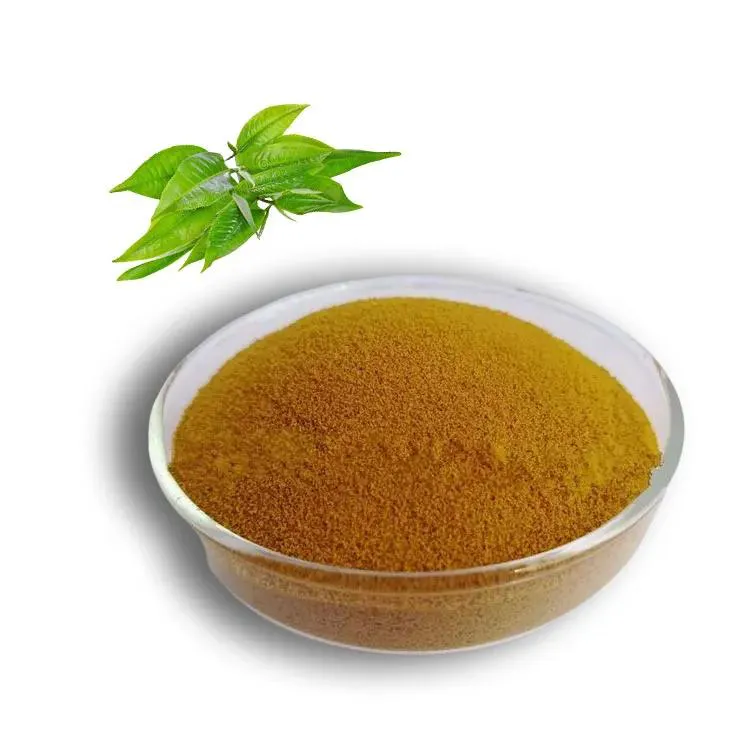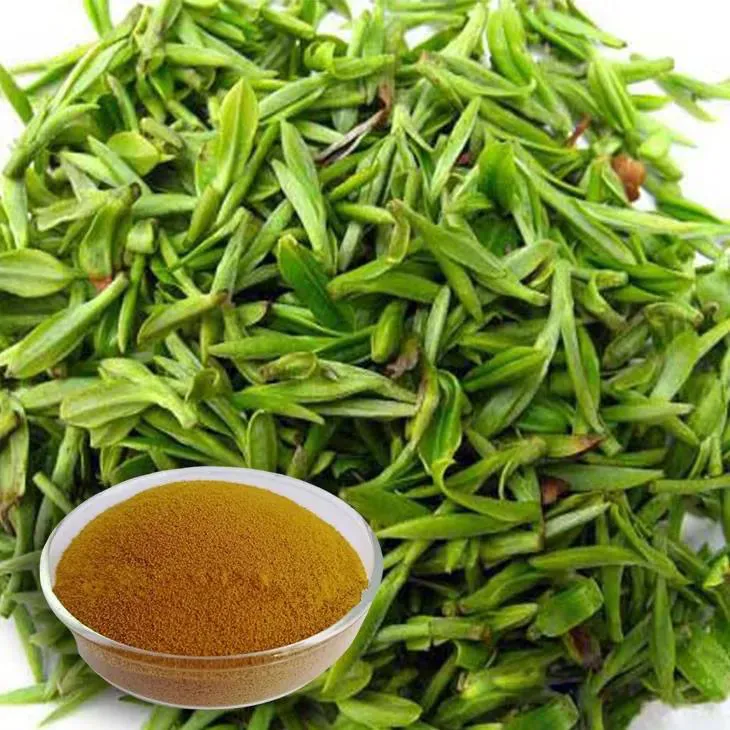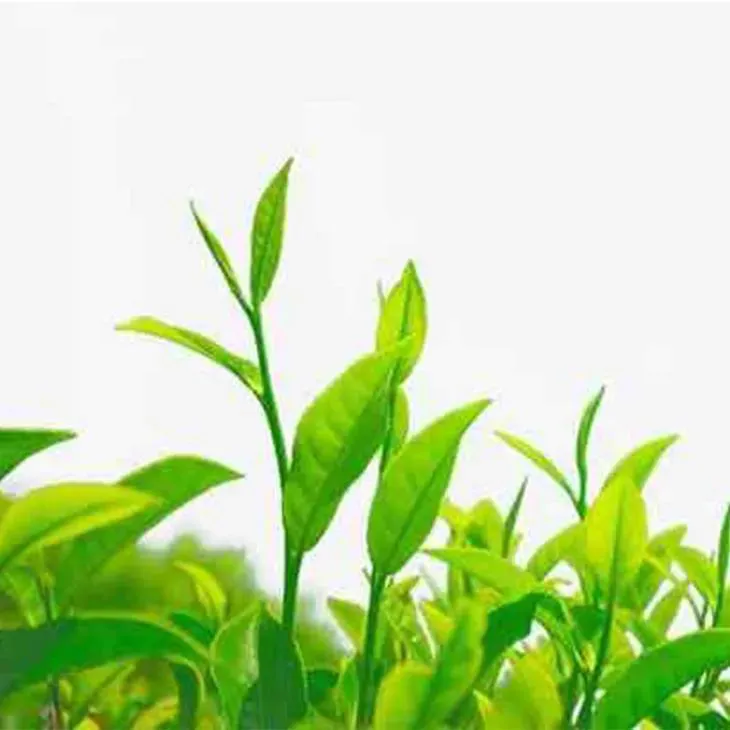- 0086-571-85302990
- sales@greenskybio.com
Green Tea Extract: From Leaves to Extraction.
2024-11-11

Cultivation of Green Tea Leaves
Green tea is primarily cultivated in countries like China and Japan, although it is also grown in other parts of the world. The ideal climate for green tea cultivation is a warm, humid environment with well - drained soil. High - altitude areas are often preferred as they can provide cooler temperatures and more sunlight, which contribute to the production of high - quality leaves.
Green tea plants are usually grown in large plantations or small - scale farms. Farmers need to pay attention to various factors during cultivation. For example, proper irrigation is crucial to ensure that the plants receive enough water, especially during dry seasons. Also, pest control is necessary to protect the leaves from being damaged by insects and other pests. Organic farming methods are increasingly popular for green tea cultivation as they can produce leaves without the use of harmful pesticides and fertilizers, which is beneficial for the production of high - quality Green Tea Extract.

Harvesting of Green Tea Leaves
The harvesting of green tea leaves is a delicate process. It typically occurs several times a year, depending on the variety of the tea plant and the local climate. The first harvest, known as the "first flush," usually produces the highest - quality leaves. These leaves are young, tender, and contain a high concentration of beneficial compounds.
Harvesting methods can vary. In some cases, the leaves are hand - picked, which is a labor - intensive but precise method. Hand - picking allows workers to select only the youngest and most suitable leaves for harvest. In larger plantations, mechanical harvesting may be used, but this method may also collect some older or damaged leaves, which can affect the quality of the final extract.

Extraction Techniques
Solvent Extraction
One of the common extraction techniques for Green Tea Extract is solvent extraction. Ethanol and water are often used as solvents. In this process, the green tea leaves are first ground into a fine powder to increase the surface area for extraction. Then, the powdered leaves are mixed with the solvent and allowed to soak for a certain period of time. The solvent helps to dissolve the active compounds in the leaves, such as polyphenols and catechins.
After soaking, the mixture is filtered to separate the liquid extract from the solid residue. The solvent is then removed through evaporation or other methods, leaving behind the concentrated Green Tea Extract. However, solvent extraction may have some drawbacks. For example, if the solvent is not completely removed, it may leave residues in the extract, which could be a concern for some applications.
Supercritical Fluid Extraction
Supercritical fluid extraction is another advanced technique. Carbon dioxide in its supercritical state is often used as the extraction medium. Supercritical carbon dioxide has properties similar to both a gas and a liquid, which makes it an excellent solvent for extracting bioactive compounds from green tea leaves.
This method has several advantages. It is a relatively clean process as carbon dioxide is non - toxic and can be easily removed from the extract. Also, it can selectively extract specific compounds, depending on the extraction conditions. However, the equipment for supercritical fluid extraction is more expensive compared to solvent extraction, which may limit its widespread use in some smaller - scale operations.

Quality Factors Affecting the Final Extract
Origin of the Leaves
The origin of green tea leaves plays a significant role in the quality of the final extract. Different regions may have different soil compositions, climates, and cultivation practices, all of which can influence the chemical composition of the leaves. For example, green tea from Japan may have different characteristics compared to that from China. Japanese green tea is often known for its delicate flavor and high content of certain amino acids, while Chinese green tea may be rich in different types of polyphenols.
Leaves from high - quality tea - growing regions are more likely to produce extracts with a higher concentration of beneficial compounds. Additionally, the altitude at which the tea is grown in the origin area can also affect the quality. As mentioned earlier, high - altitude tea leaves tend to have better quality due to factors such as cooler temperatures and more sunlight exposure.
Extraction Conditions
The extraction conditions, including temperature, pressure, and extraction time, are crucial factors affecting the final extract. For solvent extraction, the choice of solvent and its concentration can also impact the quality. If the temperature is too high during extraction, it may cause the degradation of some active compounds in the leaves. For example, catechins are sensitive to high temperatures and may be oxidized or otherwise altered, reducing their beneficial properties in the extract.
Similarly, if the extraction time is too long or the pressure is not properly controlled in supercritical fluid extraction, it can lead to over - extraction or the extraction of unwanted compounds. Therefore, precise control of extraction conditions is necessary to obtain a high - quality green tea extract with the desired composition of active compounds.
Health - related Benefits of Green Tea Extract
Potential Anti - cancer Effects
Green tea extract has been studied for its potential anti - cancer effects. The polyphenols, especially catechins, in green tea extract are believed to play a role in preventing cancer. Epigallocatechin - 3 - gallate (EGCG) is one of the most studied compounds in this regard. It has been shown to inhibit the growth of cancer cells in vitro and in some animal models.
Studies have suggested that EGCG may work by interfering with the signaling pathways that promote cancer cell growth and survival. It may also induce apoptosis (programmed cell death) in cancer cells. However, more research is needed to fully understand the mechanisms and to determine whether green tea extract can be effectively used in cancer prevention or treatment in humans.
Role in Promoting Heart Health
Green tea extract is also beneficial for heart health. It may help to lower blood pressure, reduce cholesterol levels, and improve blood vessel function. The polyphenols in the extract can act as antioxidants, protecting the heart and blood vessels from oxidative stress.
Some research has shown that regular consumption of green tea or its extract may be associated with a reduced risk of heart disease. For example, it can inhibit the oxidation of low - density lipoprotein (LDL) cholesterol, which is a key step in the development of atherosclerosis. Additionally, green tea extract may have anti - inflammatory properties that can further contribute to heart health by reducing inflammation in the blood vessels.
Other Health Benefits
Besides anti - cancer and heart - health benefits, green tea extract has other potential health benefits. It may have a positive impact on weight management. Some studies suggest that the compounds in green tea extract can increase thermogenesis (the process of heat production in the body), which may help to burn more calories. It may also improve cognitive function, potentially reducing the risk of neurodegenerative diseases such as Alzheimer's and Parkinson's.
Furthermore, green tea extract has been investigated for its anti - diabetic properties. It may help to regulate blood sugar levels by improving insulin sensitivity. However, while these potential benefits are promising, more clinical studies are required to confirm their effectiveness and to determine the appropriate dosage for different health applications.
FAQ:
How are green tea leaves cultivated for extraction?
Green tea leaves are typically cultivated in areas with suitable climate conditions, including proper temperature, humidity, and sunlight. They require well - drained soil. Tea plants are usually grown on slopes to ensure good drainage. The cultivation also involves proper pruning and care to promote healthy growth of the leaves. Organic farming methods may be used to ensure high - quality leaves for extraction, which helps to avoid contamination from pesticides and other chemicals.
What are the common extraction techniques for green tea extract?
One common extraction technique is solvent extraction. Ethanol or water can be used as solvents to extract the active compounds from the green tea leaves. Another method is supercritical fluid extraction, often using carbon dioxide in a supercritical state. This method has the advantage of being able to extract compounds without leaving solvent residues. Steam distillation can also be used in some cases, especially for extracting volatile components from green tea.
How does the origin of green tea leaves affect the extract?
The origin of green tea leaves can have a significant impact on the extract. Different regions may have different soil compositions, climates, and altitudes. For example, green tea leaves from high - altitude regions may have a different chemical composition compared to those from lower - altitude areas. The soil in certain regions may be rich in specific minerals, which can influence the growth and the content of bioactive compounds in the leaves. These differences in the leaves will then be reflected in the quality and properties of the final extract.
What are the main health benefits of green tea extract?
Green tea extract has several potential health benefits. It may have anti - cancer effects, as some of its compounds like catechins are believed to inhibit the growth of cancer cells. It also plays a role in promoting heart health by reducing cholesterol levels and improving blood vessel function. Additionally, it has antioxidant properties, which can help to protect the body's cells from damage caused by free radicals. Green tea extract may also be beneficial for weight management as it can potentially increase metabolism.
How important are the extraction conditions for green tea extract?
The extraction conditions are very important for green tea extract. Temperature, for instance, can affect the solubility of different compounds in the solvent. If the temperature is too high, some of the beneficial compounds may be degraded. The choice of solvent and the extraction time also play crucial roles. A proper solvent should be able to selectively extract the desired compounds. Longer extraction times may increase the yield but could also lead to the extraction of unwanted substances if not carefully controlled.
Related literature
- Green Tea Extract: Chemical Composition, Health Benefits, and Its Application in Food Industry"
- "The Extraction and Bioactivity of Green Tea Polyphenols"
- "Green Tea: Cultivation, Processing, and Health - Promoting Properties"
- ▶ Hesperidin
- ▶ Citrus Bioflavonoids
- ▶ Plant Extract
- ▶ lycopene
- ▶ Diosmin
- ▶ Grape seed extract
- ▶ Sea buckthorn Juice Powder
- ▶ Fruit Juice Powder
- ▶ Hops Extract
- ▶ Artichoke Extract
- ▶ Mushroom extract
- ▶ Astaxanthin
- ▶ Green Tea Extract
- ▶ Curcumin
- ▶ Horse Chestnut Extract
- ▶ Other Product
- ▶ Boswellia Serrata Extract
- ▶ Resveratrol
- ▶ Marigold Extract
- ▶ Grape Leaf Extract
- ▶ New Product
- ▶ Aminolevulinic acid
- ▶ Cranberry Extract
- ▶ Red Yeast Rice
- ▶ Red Wine Extract
-
Alfalfa Meal
2024-11-11
-
Maitake Mushroom Extract
2024-11-11
-
Beetroot juice Powder
2024-11-11
-
Chaste Berry Extract
2024-11-11
-
Eyebright Extract
2024-11-11
-
Avocado Extract Powder
2024-11-11
-
Yellow Pine Extract
2024-11-11
-
Nettle Root Extract
2024-11-11
-
melatonin extract
2024-11-11
-
American Ginseng Root Extract
2024-11-11





















